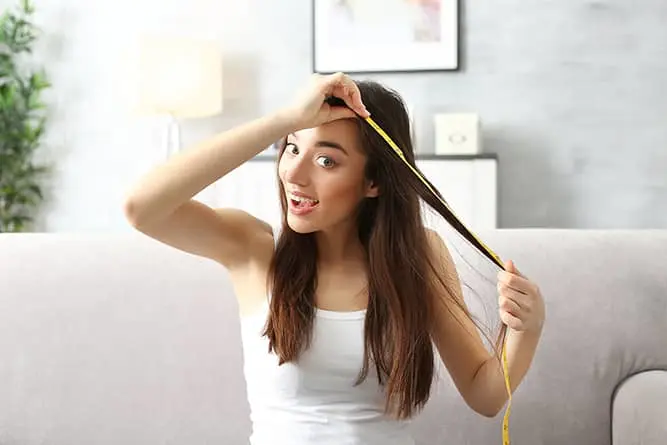Hair grows from the bottom of a follicle under your skin. The blood in your scalp travels to the follicle and delivers oxygen and nutrients to the hair root, promoting hair growth. Your hair pushes through your skin and passes through an oil gland. This gland makes your hair shiny and soft. This, in short, sums up how hair grows. Therefore, healthy hair and scalp means longer hair. 85
1.Go easy on the heat 86
Heat from curling irons, hair dryers, and straighteners can damage and break your hair and prevent it from hair growth. While you may not be able to avoid using heat styling tools entirely, you may want to try limiting how frequently you use them to better your hair growth processes. Reduced hair damage can also be achieved by lowering the temperature of heated styling tools.
2.Treat your hair with kindness 87
Bleach and other chemical hair treatments, such as permanents, weaken your hair, making it more likely to break before it reaches the desired length, ultimately, impacting your hair growth. Also, if your hair is prone to breaking, it requires special care. Avoid over-washing and perform touch-ups sparingly. Don’t forget to give your hair a hot oil treatment every two weeks to promote hair growth.
3.Trim occasionally 88
Split ends can travel up your hair shafts, shortening your hair even more, making hair growth nearly impossible. So, make sure you trim your hair once every three weeks for better hair growth.
4.Less stress, more growth 89
Serious stress can cause hair to enter a resting phase, skipping the stage that encourages hair growth. It may increase your chances of developing alopecia areata, a condition in which your immune system attacks your hair follicles and prevents it from hair growth.
5.Put your hair in good condition with conditioners 90
Conditioner should be used every time you shampoo. It not only improves the behavior and appearance of your hair, but it also strengthens it and protects it from the sun's harmful UV rays, promoting hair growth. Apply it only to the bottom of your hair if you have fine hair to avoid weighing it down. Coat the tips of your hair thoroughly to nourish the ends.
6.Watch out for a nutrient deficiency 91
There is no supplement that has been proven to increase hair growth. However, if you are deficient in certain nutrients, it can have an impact on your hair. Anemia, caused by a lack of iron, can result in hair loss. Vitamins B and D play an important role in maintaining healthy hair. Zinc, omega-3 fatty acids, and the B vitamin biotin all play a role.
7.Or just have a healthy diet! 92
Eat a well-balanced diet rich in iron, B vitamins, vitamin E, protein, and zinc. Biotin can be found in foods other than vitamins, such as nuts, eggs, leafy greens, avocado, salmon, and cauliflower. Iron deficiency is frequently the cause of hair falling out before it reaches its full length, so consider increasing your intake through red meat, dark leafy greens, and beetroot.
8.Massage that scalp 93
Massages are known to help relieve stress, and stress can contribute to hair loss. They also feel great. Make use of a scalp massager. In fact, a few studies have suggested that regular head massages may aid in thicker hair growth.
9.Treat your hair like royalty 94
Encourage your hair to grow to impressive lengths by sleeping on silk pillowcases to reduce tangles, breakage, and damage, and to preserve all of your hard work from the preceding steps.
10.Accessorize less 95
Restrict the use of hair clips, extensions, and tight braids that can cause tension. Simply wearing your hair in the same hairstyle every day, such as a ponytail, can cause your hair to break over time. Here are some other hair loss causes to consider.
In conclusion, there is no magic potion to help your hair grow overnight; however, following the hair growth tips promotes hair growth in a steady and a healthy manner and to nudge those hair follicles into action. Also, it is proven that use of Regaine® helps in hair regrowth. Regaine® works by restoring inactive hair follicles to lengthen your hair’s active growth phase!
References:
85 Montagna, W., & Ellis, R. A. (Eds.). (2013). The biology of hair growth. Elsevier.
86 Lee, Y., Kim, Y. D., Hyun, H. J., Pi, L. Q., Jin, X., & Lee, W. S. (2011). Hair shaft damage from heat and drying time of hair dryer. Annals of dermatology, 23(4), 455-462.
87 Imai, T. (2011). The influence of hair bleach on the ultrastructure of human hair with special reference to hair damage. Okajimas folia anatomica Japonica, 88(1), 1-9.
88 Swift, J. A. (1999). The mechanics of fracture of human hair. International journal of cosmetic science, 21(4), 227-239.
89 Thom, E. (2016). Stress and the Hair Growth Cycle: Cortisol-Induced Hair Growth Disruption. Journal of drugs in dermatology: JDD, 15(8), 1001-1004.
91 Finner, A. M. (2013). Nutrition and hair: deficiencies and supplements. Dermatologic clinics, 31(1), 167-172.
92 Guo, E. L., & Katta, R. (2017). Diet and hair loss: effects of nutrient deficiency and supplement use. Dermatology practical & conceptual, 7(1), 1.
93 Koyama, T., Kobayashi, K., Hama, T., Murakami, K., & Ogawa, R. (2016). Standardized scalp massage results in increased hair thickness by inducing stretching forces to dermal papilla cells in the subcutaneous tissue. Eplasty, 16.
94 https://www.nytimes.com/wirecutter/blog/my-favorite-hair-care-tool-is-a-silk-pillowcase/
95 https://www.aad.org/public/diseases/hair-loss/treatment/tips

